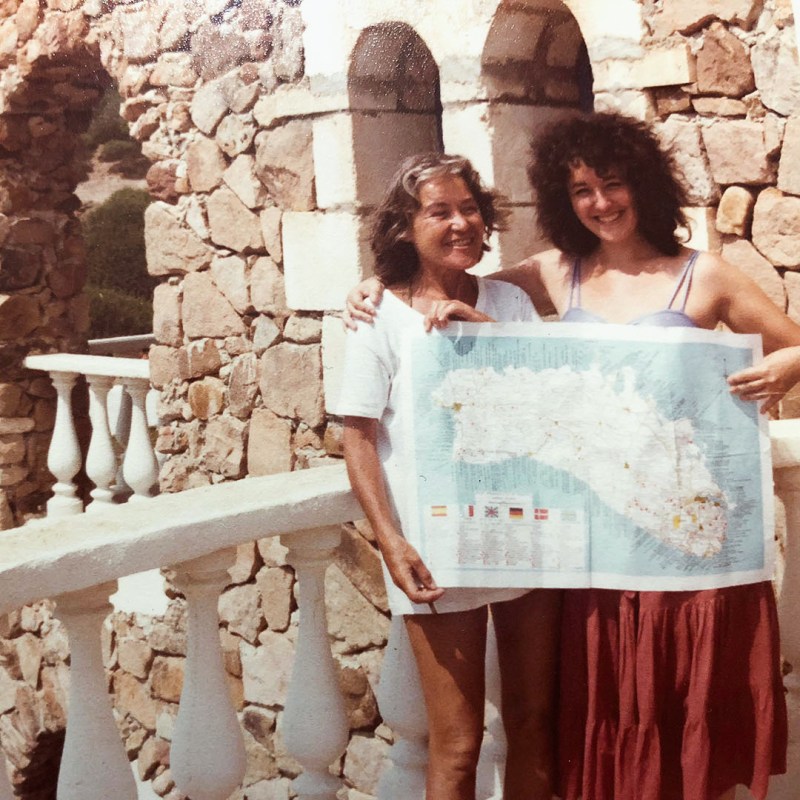
Barbara Winard
Menorca, Spain, is a jewel — a Balearic island emerging from the waters of the Mediterranean about eight hours by ferry from Barcelona. There are numerous reasons for visiting the island. It is a quiet and serene place, largely protected from development since being named a UNESCO Biosphere Reserve in 1993. It is easier to navigate and less frenetic than its famous (and much larger) neighbor, Majorca. Menorca’s culture is purely Catalan, but all across the island you feel the remnants and ghosts of its Roman, Byzantine, and Islamic past.
Videos by TravelAwaits
But Menorca’s beauty, history, and unique topography were not the main reasons for my return there, some 40 years after I had originally visited.
I returned to Menorca in order to revisit a time, a place, and a person — and to share an experience that fueled my love of exploring the world with my 27-year-old daughter, a budding traveler herself.

Barbara Winard
Finding My Travel Guru
I first met Joy about 50 years ago, when I started a job as a writer for New York City’s public television station. Joy was about 15 years older than I was, and she fit the bill for a dear mother/friend. Joy had done it all and seen it all, and she was enthusiastic about my journey, too. She and her husband had traveled the world from the 1940s on, and they did it the hard way: cheaply and ruggedly.
Her one immovable overseas destination was a house that she and her husband had built in the 1960s on the island of Menorca. A photograph of that house — a one-story stone building perched on a cliff next to the ruins of an ancient tower — held a place of honor in her New York City home.
In the early 1980s Joy invited me to visit her in Menorca, and I flew from Barcelona to the island without telling her exactly when I was arriving. I headed for a phone booth to ask her to pick me up at the airport. But it turned out that there was no phone book or, as I soon learned, even a phone. I didn’t have her address, so I wandered the streets of Menorca’s capital city, Mahon, until I figured out what to do.
Eventually I convinced a taxi driver to drive to the small town where she lived, and I recognized her house from the photograph on her New York City wall. I walked into a festive party, and the rest of my time there was filled with Joy’s warmth and a houseful of her friends. I remember exploring the megalithic monuments dotting the roads, hanging out at a bar in Mahon where we drank and sang, taking motorcycle rides through the countryside, and walking down the hill to a pristine beach.
Almost four decades have passed since then. About a year ago, my daughter and I talked about traveling to a Spanish-speaking country so she could practice her Spanish. All at once I knew that I would take her to Menorca.

Barbara Winard
Traveling To Plumb The Past
We rented rooms above a restaurant overlooking the port in Mahon and wandered the streets of the city. In the mornings we studied Spanish (most of the 93,000 people who live there speak both Catalan and Spanish). In the afternoons, we headed out to explore ruins, beaches, and towns in Menorca’s interior and on the coasts.
My kid loved the island immediately. Things had changed; there were more tourists and expats than I remembered, more vacation homes and new buildings. But what Menorca was had not changed. Its standing stones still stand; the pine-studded cliffs still overlook the beaches; the 13th-century church in the Old Town of Ciutadella still looms; the ruins from Menorca’s diverse past still dot the island.
Because of the efforts to preserve its natural beauty and diversity, the ponds, lagoons, marshes, and dunes of the island are home to thousands of species of birds and plants. Also preserved are mysterious burial sites called talayots and navetas from the Bronze Age and earlier. Trepuco, near Mahon, contains the largest and best-preserved taula (stone monuments, from the Catalan word for “table”) in the Balearic islands. As opposed to visiting the archaeological sites of other countries, we could examine these ruins up close with no barriers.

Barbara Winard
But I saved the best for the sunniest and clearest day. We drove to Sa Mesquida to visit Joy’s house. As we approached, I spotted it — right past the old tower, on the cliff. The house was a different color but was instantly recognizable.
I suddenly felt caught in a time warp: at once suffused with memories of the past but also seeing with new eyes, aware that I now had a different life and a suitcase packed with four decades of experience. We parked the car and stood and gazed at the house for a long time — quietly. Then we hiked down to the sea. There were just a few people on the beach. My daughter and I walked on the hot sand, appreciating the solitude and the breeze. She stopped to hug me, saying nothing. We stood that way for a very long time.

Barbara Winard
Travel As A Continuum
It became clear to me that this journey provided a direct link between my young self and the person I’ve become. It also forged new connections with my daughter. Not only did I share my life experiences with her; the journey also provided her with her own stories to share with her future family. We have traveled together several times since our Menorca journey, and I can see that her travel wings have taken hold.
Travel, for me — and I believe for her, too — is so much more than seeing the sights and adding stamps to our passports. Travel is also paying respect to the past and to the people we have loved. I had mistakenly believed that, since there are so many places to see in the world, there was no reason to return to those visited in the past. I was wrong. It now seems to me that by setting off on a road already traveled, there is the possibility that we may come to better understand where we have started and how far we have come.
Pining for the coast of Spain? These are the best things to see and do in nearby Palma de Mallorca.
